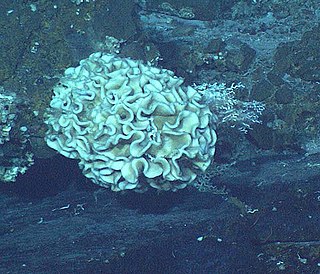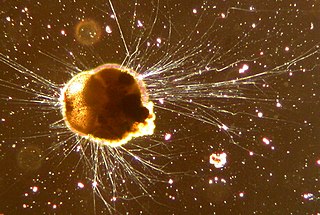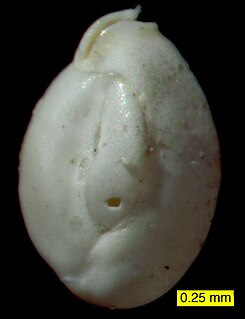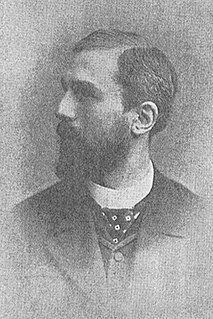
Xenophyophorea is a clade of foraminiferans. Members of this class are multinucleate unicellular organisms found on the ocean floor throughout the world's oceans, at depths of 500 to 10,600 metres. They are a kind of foraminiferan that extracts minerals from their surroundings and uses them to form an exoskeleton known as a test.

Foraminifera are single-celled organisms, members of a phylum or class of amoeboid protists characterized by streaming granular ectoplasm for catching food and other uses; and commonly an external shell of diverse forms and materials. Tests of chitin are believed to be the most primitive type. Most foraminifera are marine, the majority of which live on or within the seafloor sediment, while a smaller number float in the water column at various depths. Fewer are known from freshwater or brackish conditions, and some very few (nonaquatic) soil species have been identified through molecular analysis of small subunit ribosomal DNA.

The Rhizaria are a species-rich supergroup of mostly unicellular eukaryotes. Except from the Chlorarachniophyte and three species in the genus Paulinella in the phylum Cercozoa, they are all non-photosynthethic, but many foraminifera and radiolaria have a symbiotic relationship with unicellular algae. A multicellular form, Guttulinopsis vulgaris, a cellular slime mold, has also been described. This supergroup was proposed by Cavalier-Smith in 2002. Being described mainly from rDNA sequences, they vary considerably in form, having no clear morphological distinctive characters (synapomorphies), but for the most part they are amoeboids with filose, reticulose, or microtubule-supported pseudopods. Many produce shells or skeletons, which may be quite complex in structure, and these make up the vast majority of protozoan fossils. Nearly all have mitochondria with tubular cristae.
The principle of faunal succession, also known as the law of faunal succession, is based on the observation that sedimentary rock strata contain fossilized flora and fauna, and that these fossils succeed each other vertically in a specific, reliable order that can be identified over wide horizontal distances. A fossilized Neanderthal bone will never be found in the same stratum as a fossilized Megalosaurus, for example, because neanderthals and megalosaurs lived during different geological periods, separated by many millions of years. This allows for strata to be identified and dated by the fossils found within.
Lukas Hottinger was a paleontologist, biologist and geologist. Hottinger collaborated with the Natural History Museum of Basel (Switzerland).

Quinqueloculina is a genus of foraminifera in the family Miliolidae.

Carterinida is an order of multi-chambered foraminifera within the Globothalamea. Members of this order form hard tests out of thin calcite rods known as spicules, which are held together by a proteinaceous matrix.

Cibicides is a genus of cosmopolitan benthic foraminifera known from at least as far back as the Paleocene that extends down to the present.
Hedbergella is an extinct genus of planktonic foraminifera from the Cretaceous, described by Loeblich and Tappan, 1961, as:
Test free, trochospiral, biconvex, umbilicate, periphery rounded with no indication of keel or poreless margin; chambers globular to ovate; sutures depressed, radial, straight or curved; wall calcareous, finely perforate, radial in structure, surface smooth to hispid or rugose; aperture an interiomarginal, extraumbilical-umbilical arch commonly bordered above by a narrow lip or spatulate flap, ... Includes species otherwise similar to Praeglobotruncana but which lack a keel or poreless margin, hence is regarded as a separate genus rather than as a subgenus of Praeglobotruncana as by Banner and Blow (1959).
Globigerinoides is an extant genus of shallow-water planktonic foraminifera of family Globigerinidae. First appearing in the Oligocene these foraminifera are found in all modern oceans. Species of this genus occupy the euphotic zone, generally at depths between 10-50m, in waters which cover a range of salinities and temperatures. They are a shorter lived species, especially when compared to Globorotalia genus. As a genus Globigerinoides is widely used in various fields of research including biostratigraphy, isotope geochemistry, biogeochemistry, climatology, and oceanography.

Spiculosiphon oceana is a giant species of foraminifera. Its appearance and lifestyle mimics that of a sponge. It was discovered in 2013 in underwater caves 30 miles off the coast of Spain.

Santo Domingo Formation is a mainly marine Miocene sedimentary formation located in south–central Chile. The formation was defined by R. Martínez Pardo and Mario Pino in 1979 and named after the roadcut locality they studied about 19 kilometres (12 mi) southeast of Valdivia. Sediments of the formation accumulated in Valdivia and Osorno–Llanquihue Basin.
Helen Niña Tappan Loeblich was an American micropaleontologist who was a professor of geology at the University of California, Los Angeles, a United States Geological Survey (USGS) biostratigrapher, and a scientific illustrator whose micropaleontology specialty was research on Cretaceous foraminifera.

Cyclammina is a genus of foraminifers in the family Cyclamminidae. Most species are extinct, but there are a few that are extant.

Cuneolina is an extinct genus of prehistoric foraminifera in the family Cuneolinidae with species from the Jurassic and Cretaceous.

"Monothalamea" is a grouping of foraminiferans, traditionally consisting of all foraminifera with single-chambered tests. Recent work has shown that the grouping is paraphyletic, and as such does not constitute a natural group; nonetheless, the name "monothalamea" continues to be used by foraminifera workers out of convenience.
Acarinina is an extinct genus of foraminifera belonging to the family Truncorotaloididae of the superfamily Globorotalioidea and the suborder Globigerinina. Its fossil range is from the upper Paleocene to the middle Eocene. Its type species is Acarinina nitida.
Heterohelix is an extinct genus of foraminifera belonging to the family Heterohelicidae of the superfamily Heterohelicoidea and the suborder Globigerinina. Its type species is Heterohelix americana.
Hedbergellidae is an extinct family of foraminifera belonging to the superfamily Rotaliporoidea and the suborder Globigerinina.

Cavaliere dottoreCarlo Fornasini was an Italian micropalaeontologist who specialised in Foraminifera ('forams'). He was a pioneer in using fossil forams to sequence marine sedimentary deposits by their relative dates; a technique called biostratigraphy.









